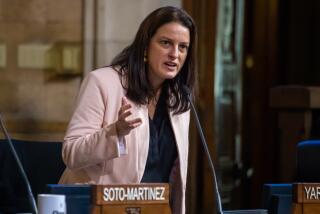STATE PANEL SEEKS PRIVATE FUNDS
- Share via
Robert H. Reid, director of the California Arts Council, will go out looking for money for the arts this month with a new hat in hand. For the first time in the council’s history, Reid will be asking the private sector for funds instead of asking Gov. George Deukmejian to boost the state’s arts budget.
That kind of solicitation doesn’t sit well with many members of the council’s constituency.
Though they stand to benefit from the new project, many arts groups officials fear it will cut short their own funds by easing the pressure for public arts funding and creating competition for private funds between their groups and the council.
“People in the field are very nervous about this,” said Susan Hoffman, director of the California Confederation of the Arts, the state’s arts advocacy organization. Artists and heads of arts groups worry that the new program will cause them to compete with the state agency’s clout for funds, she explained.
“But it’s not just the competition,” Hoffman added. “It’s the fear that the council won’t go the full nine yards” to fight for a bigger budget from the state, and to increase public spending on the arts to $1 per capita by 1990, a primary confederation goal. California now spends about $13.5 million on the arts, or 50 cents per capita, ranking it about 30th in per-capita spending among the 56 states and U.S. territories.
“The arts community supports the council’s intent,” said Bonnie Brittain Hall, development director for South Coast Repertory. “But it is wary of any ideas that might ease the pressure for public funding. The case we’re trying to make with the governor is that the dollar-per-capita spending we’re hoping for by 1990 will come out of the public sector, not out of the private sector.”
The first of various projects the Republican-dominated council plans to supplement with funds from private corporations, foundations and individuals is its new grant program for individual artists, more of whom live in California than in any other state in the nation, according to the National Assembly for State Arts Agencies. Currently, the council has $200,000 in the new program to award $5,000 fellowships to 40 artists early next year.
“When we start our individual artists program, the need and demand is going to just be absolutely immense,” said Reid, who with nine of the 11 council members, is a Deukmejian appointee.
Added council member Gerald Yoshitomi, director of the Japanese American Cultural and Community Center in Los Angeles: “In general, the new funding program is valuable because the council can raise funds for emerging arts groups, who, without nonprofit tax status, can’t do their own fund-raising. And it’s beneficial to individual artists who would have a hard time making their case with foundations and corporations, many of which only fund arts groups,” because of restrictive tax policies.
“No one can argue that funding individual artists is a worthy cause,” said Robin M. Hanson, grants officer at the Museum of Contemporary Art. “But augmenting council programs with private dollars is possibly an escape hatch for Deukmejian, who is not as interested in supporting the arts as administrators in other states are.”
While comprehensive, up-to-date statistics are not available, it appears that no other state agency maintains an ongoing private-sector fund-raising program like the California Arts Council’s. Even Reid called the council’s new project “a uniquely California situation.”
Both the New York and Massachusetts arts councils, two of the nation’s leading agencies in per-capita arts spending, work in association with foundations that raise private monies. But both foundations are incorporated as private, nonprofit entities separate from their councils.
Until June, the California Arts Council had planned to create a wholly separate foundation to run its private fund-raising program. But the idea was “put on hold,” Reid said, to avoid the red tape of creating the foundation and in favor of a mechanism that would ensure council control over private monies raised.
Thus, the program will function as an arm of the council, without its own separate tax status, and will encompass a “support and advisory group” of not more than 24 fund-raisers to be appointed by council members, who will determine how all private monies are to be spent.
Even in this form, however, the plan has received criticism. A spokeswoman for another leading state arts agency, the Ohio Arts Council, said that the Ohio council has no permanent mechanism for raising private funds, “because we believe we would be in direct competition with the organizations we support.”
Reid, who has been urging the council to mix public and private dollars, refutes this notion.
“I’ve always maintained that raising funds from the private sector won’t cause competition because we will never knowingly solicit funds in an either-or situation,” he said. “That is, if we go to a private funding source that tells us ‘we’re going to give money to you instead of to a certain arts organization,’ we’ll say ‘no thank you’ . . . and if a source doesn’t tell us this, if we get calls from our grantees saying ‘we got our grants cut off,’ we’ll change our policy.”
Reid also says that the 11-year-old council will try to solicit funds from private sources that do not already give to the arts, or, as with the council’s individual artists program, will raise funds for programs typically underfunded.
“And we won’t let private money be an excuse for no more public money,” Reid says. “This is about a mix of the two, it’s not about one in lieu of the other.”
However, several private-sector funders in the state also have reservations about the new program.
“There is the danger that private-sector contributions to state agency activities could supplant the state’s need to participate in supporting the arts,” said Eric Peterson, program officer at the Hewlett Foundation, which annually gives about $4 million to arts organizations, most in the Bay Area.
Peterson added that a grant from the Hewlett Foundation to the council would “completely, flat out” deny a Hewlett Foundation grant to another arts organization.
Lucretia Cloran, program officer at Arco Foundation, said, “I’m not sure we would say no (to a council request for funds), but it would take a long time to consider something like that. Last year, Cloran said, the Arco Foundation gave $2.4 million to the arts nationwide (from a total of about $18 million in philanthropic giving).
Jeanette Mackelwee, contributions manager for the Carter Hawley Hale Foundation, said she supported in theory the council’s plan to seek private funds specifically for individual artists.
However, Mackelwee said that “although I can’t commit funds for Carter Hawley Hale, we wouldn’t be one of the lead givers to the program . . . and we didn’t run up to the council and say show us a specific proposal” for a contribution. Carter Hawley Hale does not publish an annual report, and Mackelwee would only say that the foundation has been giving to the arts in California for about 20 years.
John Kreidler, program executive of the San Francisco Foundation, said that foundation would not be a “permanent supporter” of its individual artists program because, like many other foundations, the San Francisco Foundation “does not see itself as a permanent supporter of any single arts program.
“But we told the council we would be interested in entertaining a funding proposal,” he said. The San Francisco Foundation last year gave $1.5 million to Northern California arts organizations.
Also, last summer, before the private sector funding program existed, Anheuser-Busch Inc. gave the council its first private donation--$10,000 for refreshments at the council’s 10-year birthday reception. Council member Bryan (Whitey) Littlefield is the general manager of Somerset Distributors Inc., which distributes Anheuser-Busch beverages.
This year, the Wells Fargo, Irvine and Mervyn’s foundations each gave the council $5,000 toward a study of the state’s ailing symphony orchestras. The Skaggs Foundation has also asked the council to submit a proposal for $75,000 for its folk arts program. The council has not yet received confirmation of this grant.
“These gifts are just the tip of the iceberg,” Reid said, “but they are a step in the right direction.
“I’m not a soothsayer, I have no idea how this is going to turn out,” he added. “I’m a hopeless optimistic, but if it turns out to be a disaster, we’ll stop it.”
More to Read
The biggest entertainment stories
Get our big stories about Hollywood, film, television, music, arts, culture and more right in your inbox as soon as they publish.
You may occasionally receive promotional content from the Los Angeles Times.










